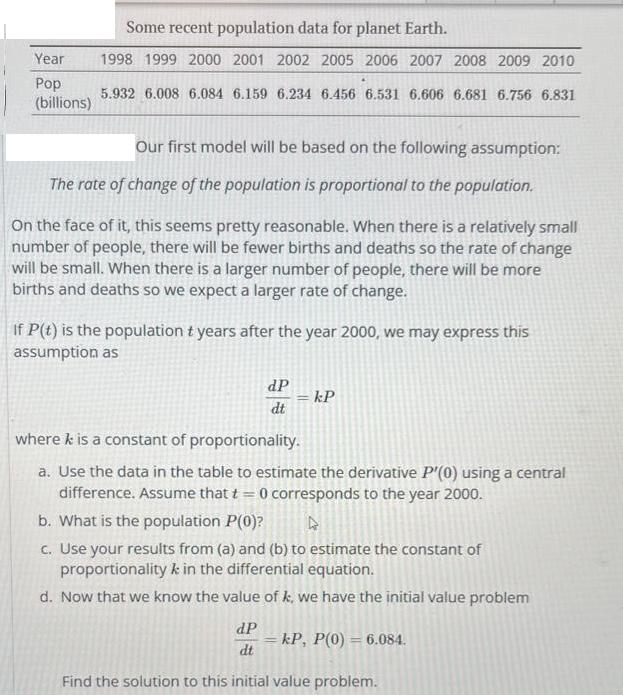Answered step by step
Verified Expert Solution
Question
1 Approved Answer
Year Pop (billions) Some recent population data for planet Earth. 1998 1999 2000 2001 2002 2005 2006 2007 2008 2009 2010 5.932 6.008 6.084


Year Pop (billions) Some recent population data for planet Earth. 1998 1999 2000 2001 2002 2005 2006 2007 2008 2009 2010 5.932 6.008 6.084 6.159 6.234 6.456 6.531 6.606 6.681 6.756 6.831 Our first model will be based on the following assumption: The rate of change of the population is proportional to the population. On the face of it, this seems pretty reasonable. When there is a relatively small number of people, there will be fewer births and deaths so the rate of change will be small. When there is a larger number of people, there will be more births and deaths so we expect a larger rate of change. If P(t) is the population tyears after the year 2000, we may express this assumption as dP dt = kP where k is a constant of proportionality. a. Use the data in the table to estimate the derivative P'(0) using a central difference. Assume that t= 0 corresponds to the year 2000. b. What is the population P(0)? 4 c. Use your results from (a) and (b) to estimate the constant of proportionality k in the differential equation. d. Now that we know the value of k, we have the initial value problem dP dt =kP, P(0) = 6.084. Find the solution to this initial value problem. e. What does your solution predict for the population in the year 2010? Is this close to the actual population given in the table? f. When does your solution predict that the population will reach 12 billion? g. What does your solution predict for the population in the year 2500? h. Do you think this is a reasonable model for the earth's population? Why or why not? Explain your thinking using a couple of complete sentences.
Step by Step Solution
★★★★★
3.37 Rating (156 Votes )
There are 3 Steps involved in it
Step: 1
a Use the data in the table to estimate the derivative P0 using a central difference Assume that t 0 ...
Get Instant Access to Expert-Tailored Solutions
See step-by-step solutions with expert insights and AI powered tools for academic success
Step: 2

Step: 3

Ace Your Homework with AI
Get the answers you need in no time with our AI-driven, step-by-step assistance
Get Started


